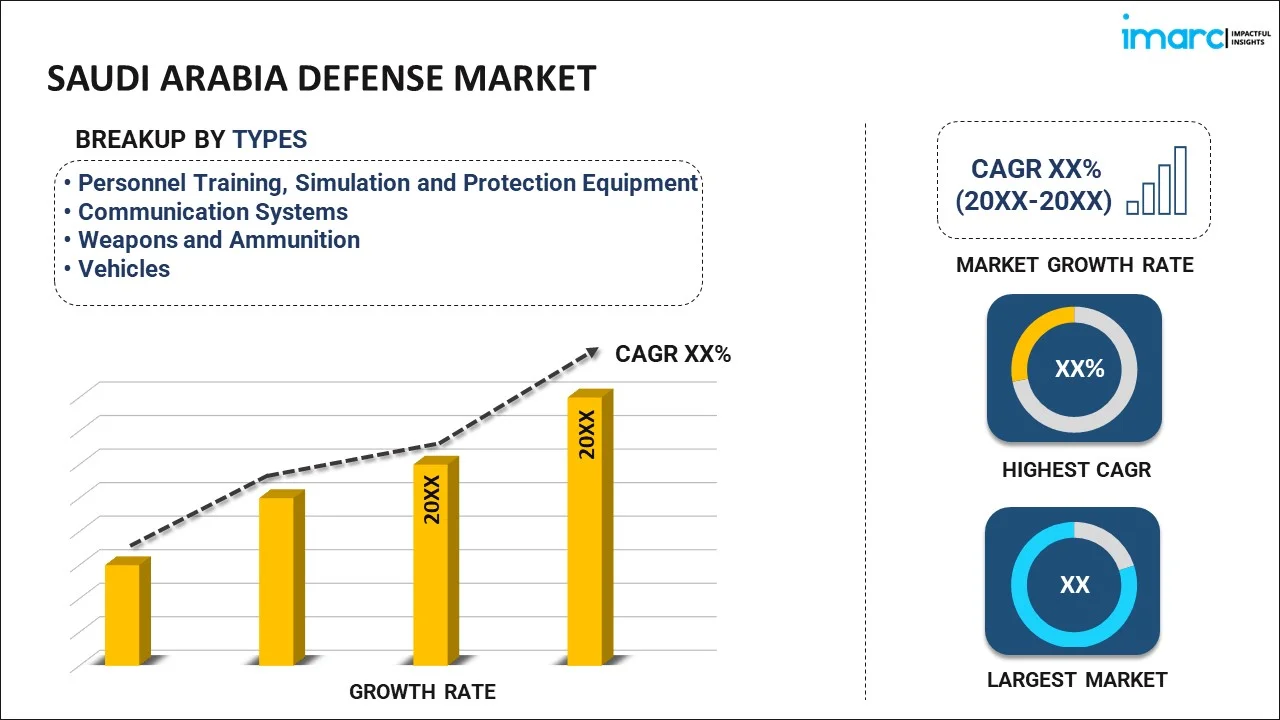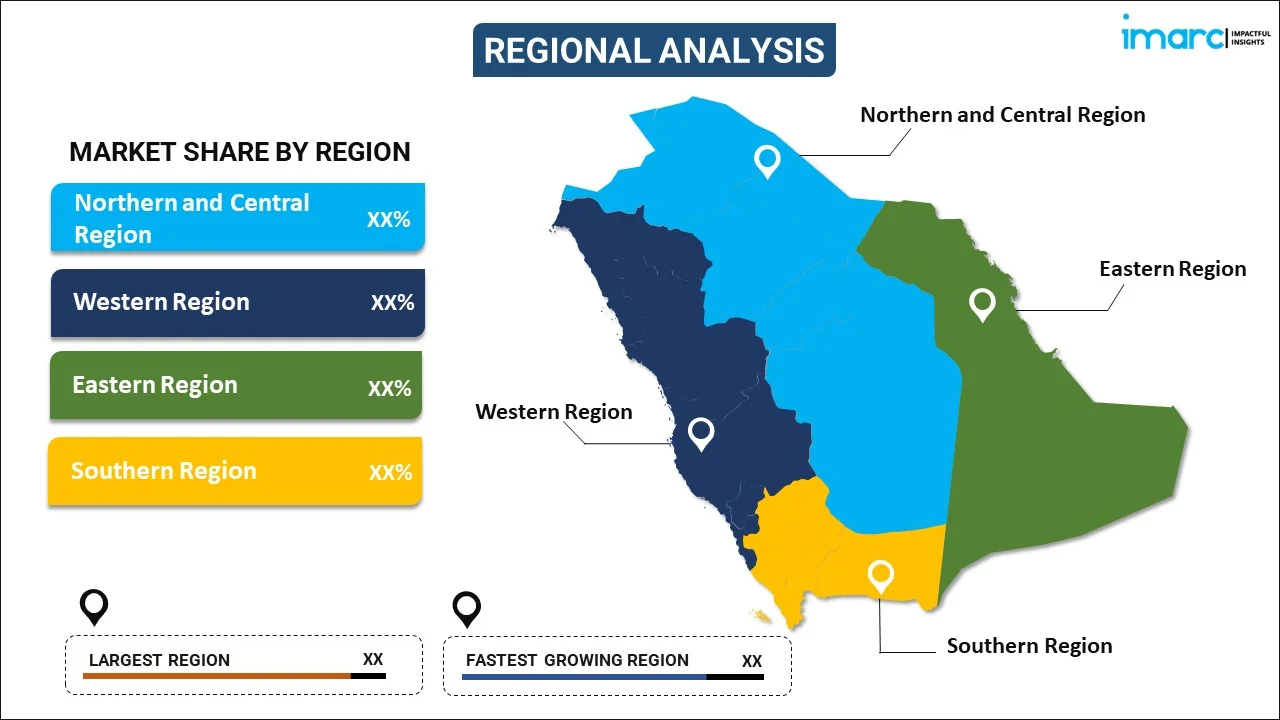
Saudi Arabia Defense Market Report by Type (Personnel Training, Simulation and Protection Equipment, Communication Systems, Weapons and Ammunition, Vehicles), and Region 2026-2034
Market Overview:
Saudi Arabia defense market size reached USD 24,034.8 Million in 2025. Looking forward, IMARC Group expects the market to reach USD 33,077.1 Million by 2034, exhibiting a growth rate (CAGR) of 3.61% during 2026-2034. The increasing need among government bodies for protecting national interests and maintain stability is primarily driving the market growth.
|
Report Attribute
|
Key Statistics
|
|---|---|
|
Base Year
|
2025
|
|
Forecast Years
|
2026-2034
|
|
Historical Years
|
2020-2025
|
| Market Size in 2025 | USD 24,034.8 Million |
| Market Forecast in 2034 | USD 33,077.1 Million |
| Market Growth Rate 2026-2034 | 3.61% |
Defense refers to the measures, strategies, and capabilities implemented by a nation or entity to protect its territory, interests, and citizens from potential threats or attacks. This protection can be physical, in the form of military forces, or strategic, through intelligence gathering and diplomatic efforts. Defense mechanisms range from ground troops, naval fleets, and air forces to cybersecurity measures, intelligence agencies, and diplomatic alliances. The primary objective is to deter or counteract any form of aggression, whether it emanates from external adversaries or internal challenges. The concept of defense extends beyond mere military might; it also encompasses the resilience of a nation's infrastructure, its readiness to handle emergencies, and its ability to maintain societal stability in the face of challenges.
Saudi Arabia Defense Market Trends:
High Defense Spending and Budget Allocation
Saudi Arabia consistently ranks among the world’s top defense spenders, allocating a significant portion of its annual budget to strengthen its military capabilities. As per the Trading Economics, military spending in Saudi Arabia rose to 80330.70 USD Million in 2024, up from 77765.30 USD Million in 2023. The government’s commitment to defense investment is largely driven by the need to secure its vast borders, critical oil infrastructure, and maritime routes. This high expenditure allows the procurement of advanced weapon systems, modernization of equipment, and expansion of military capacity across land, air, and naval forces. Budgetary allocation also supports research, training, and technology transfer initiatives. The availability of substantial funds is enabling Saudi Arabia to partner with global defense manufacturers, acquire state-of-the-art systems, and invest in next-generation technologies.
Growing Focus on Cybersecurity and Digital Defense
As warfare is evolving, Saudi Arabia is placing increasing importance on cybersecurity and digital defense, which is significantly fueling the market growth. As per the IMARC Group, the Saudi Arabia cybersecurity market size reached USD 2.6 Billion in 2024. With critical sectors, such as oil, finance, and government systems, highly dependent on digital infrastructure, cyber threats pose serious national security risks. The rise in cyberattacks targeting sensitive data, energy operations, and defense systems is encouraging heavy investments in advanced cybersecurity frameworks, digital intelligence platforms, and electronic warfare solutions. Collaborations with global tech and defense companies are strengthening Saudi Arabia’s cyber resilience, while domestic programs aim to train specialists in cyber defense.
Protection of Critical Infrastructure and Energy Assets
Saudi Arabia’s economy relies heavily on its thriving oil and gas industry, making the protection of energy infrastructure a top national priority. As per the iea, Saudi Arabia's investment in upstream oil and gas is the largest in the region, expected to approach USD 40 billion by 2025, nearly 15% more than in 2015. With pipelines, refineries, and oil fields spread across the country, safeguarding these assets against external attacks or sabotage is critical. Past incidents targeting oil facilities have reinforced the need for advanced defense systems capable of countering missile strikes, drone incursions, and cyberattacks. Consequently, the demand for missile defense, anti-drone systems, and surveillance technologies has surged. Protecting offshore platforms and maritime routes that transport oil also requires a strong naval defense presence. Investments in securing energy assets are not only safeguarding economic stability but also fueling defense spending in specialized technologies.
Key Growth Drivers of Saudi Arabia Defense Market:
Regional Geopolitical Tensions and Security Threats
The defense market in Saudi Arabia is heavily driven by persistent geopolitical tensions in the Middle East, particularly surrounding territorial disputes, border security, and regional rivalries. The kingdom is facing ongoing security challenges and potential threats from extremist groups and cross-border insurgencies. Ensuring safety against missile attacks, drones, and unconventional warfare has become a top priority. These external threats are catalyzing the demand for advanced defense systems, including missile defense technologies, radar systems, surveillance, and cyber defense capabilities. Saudi Arabia’s strategic geographic position, close to vital oil shipping lanes and the Red Sea, is further heightening its need for robust defense preparedness. Continuous investments in upgrading its defense infrastructure are thus directly linked to the volatile security environment.
Modernization of Armed Forces
Saudi Arabia’s ambition to modernize its armed forces is a significant factor propelling the market growth. The kingdom is actively replacing outdated military equipment with advanced technologies across all defense segments, including air defense systems, fighter jets, armored vehicles, and naval vessels. Modernization efforts are not limited to hardware procurement, but also encompass advanced training, simulation systems, logistics support, and assimilation of advanced technologies like artificial intelligence (AI) and robotics. These initiatives aim to enhance operational efficiency, readiness, and strategic capabilities. The encouragement for modernization is also part of Saudi Arabia’s broader Vision 2030 plan, which emphasizes building self-reliant and technologically advanced institutions. As global defense companies are entering into agreements to supply modern systems, Saudi Arabia’s modernization agenda is driving sustained demand for new products and services.
International Partnerships and Strategic Alliances
The market is driven by strong partnerships with global defense powers, enabling access to advanced technology, training, and support systems. The kingdom has long-standing defense ties with countries like the United States, the United Kingdom, and France, which supply advanced equipment ranging from fighter jets to missile systems. These partnerships also include training programs, joint exercises, and maintenance support, enhancing the effectiveness of Saudi Arabia’s armed forces. Additionally, agreements often involve technology transfer and local co-production, which align with Saudi Arabia’s goal of strengthening its domestic defense industry. Such collaborations ensure continuous inflow of advanced defense solutions while building local expertise. Furthermore, Saudi Arabia’s strategic alliances in regional and global defense networks aid in increasing interoperability and preparedness.
Saudi Arabia Defense Market Segmentation:
IMARC Group provides an analysis of the key trends in each segment of the market, along with forecasts at the country level for 2026-2034. Our report has categorized the market based on type.
Type Insights:

To get more information on this market, Request Sample
- Personnel Training, Simulation and Protection Equipment
- Communication Systems
- Weapons and Ammunition
- Artillery and Mortar Systems
- Infantry Weapons
- Missile and Missile Defense Systems
- Ammunitions
- Vehicles
- Land-based Vehicles
- Sea-based Vehicles
- Air-based Vehicles
The report has provided a detailed breakup and analysis of the market based on the type. This includes personnel training, simulation and protection equipment, communication systems, weapons and ammunition (artillery and mortar systems, infantry weapons, missile and missile defense systems, and ammunitions), and vehicles (land-based vehicles, sea-based vehicles, and air-based vehicles).
Regional Insights:

- Northern and Central Region
- Western Region
- Eastern Region
- Southern Region
The report has also provided a comprehensive analysis of all the major regional markets, which include Northern and Central Region, Western Region, Eastern Region, and Southern Region.
Competitive Landscape:
The market research report has also provided a comprehensive analysis of the competitive landscape in the market. Competitive analysis such as market structure, key player positioning, top winning strategies, competitive dashboard, and company evaluation quadrant has been covered in the report. Also, detailed profiles of all major companies have been provided.
Saudi Arabia Defense Market News:
- August 2025: India and Saudi Arabia were set to collaborate for the production of military gear, indicating enhanced defense and strategic relations. Conversations at a meeting in New Delhi addressed training, industrial collaborations, maritime cooperation, and military drills. India suggested military training for Saudi forces and examined joint efforts in cyberspace, IT, disaster response, and tactical communication to enhance their defense collaboration.
- August 2025: Saudi Arabia is set to host the third edition of the World Defense Show (WDS) in Riyadh from February 8–12, 2026, with King Salman's patronage. This significant international defense exhibition will showcase the Kingdom's commitment to innovation, international collaborations, and its effort to localize defense production in alignment with Vision 2030.
- January 2025: Turkey sought to conclude a USD 6 Billion defense deal with Saudi Arabia, involving warships, tanks, and missile systems. The agreement, potentially involving Saudi Arabia in Türkiye’s fighter jet development initiative, was anticipated to be concluded during President Recep Tayyip Erdoğan’s possible trip to the kingdom in March.
Saudi Arabia Defense Market Report Coverage:
| Report Features | Details |
|---|---|
| Base Year of the Analysis | 2025 |
| Historical Period | 2020-2025 |
| Forecast Period | 2026-2034 |
| Units | Million USD |
| Scope of the Report | Exploration of Historical and Forecast Trends, Industry Catalysts and Challenges, Segment-Wise Historical and Predictive Market Assessment:
|
| Types Covered |
|
| Regions Covered | Northern and Central Region, Western Region, Eastern Region, Southern Region |
| Customization Scope | 10% Free Customization |
| Post-Sale Analyst Support | 10-12 Weeks |
| Delivery Format | PDF and Excel through Email (We can also provide the editable version of the report in PPT/Word format on special request) |
Key Benefits for Stakeholders:
- IMARC’s industry report offers a comprehensive quantitative analysis of various market segments, historical and current market trends, market forecasts, and dynamics of the Saudi Arabia defense market from 2020-2034.
- The research report provides the latest information on the market drivers, challenges, and opportunities in the Saudi Arabia defense market.
- Porter's five forces analysis assist stakeholders in assessing the impact of new entrants, competitive rivalry, supplier power, buyer power, and the threat of substitution. It helps stakeholders to analyze the level of competition within the Saudi Arabia defense industry and its attractiveness.
- Competitive landscape allows stakeholders to understand their competitive environment and provides an insight into the current positions of key players in the market.
Key Questions Answered in This Report
The defense market in Saudi Arabia was valued at USD 24,034.8 Million in 2025.
The Saudi Arabia defense market is projected to exhibit a CAGR of 3.61% during 2026-2034, reaching a value of USD 33,077.1 Million by 2034.
As one of the largest defense spenders globally, the kingdom is investing heavily in modernizing its military equipment, including aircraft, naval systems, armored vehicles, and advanced weaponry. The government’s Vision 2030 initiative is emphasizing building domestic defense manufacturing capabilities, fostering partnerships with global defense contractors, and enhancing self-reliance. The rise in cybersecurity threats has also expanded defense spending on digital security and surveillance systems.
Need more help?
- Speak to our experienced analysts for insights on the current market scenarios.
- Include additional segments and countries to customize the report as per your requirement.
- Gain an unparalleled competitive advantage in your domain by understanding how to utilize the report and positively impacting your operations and revenue.
- For further assistance, please connect with our analysts.
 Request Customization
Request Customization
 Speak to an Analyst
Speak to an Analyst
 Request Brochure
Request Brochure
 Inquire Before Buying
Inquire Before Buying




.webp)




.webp)












